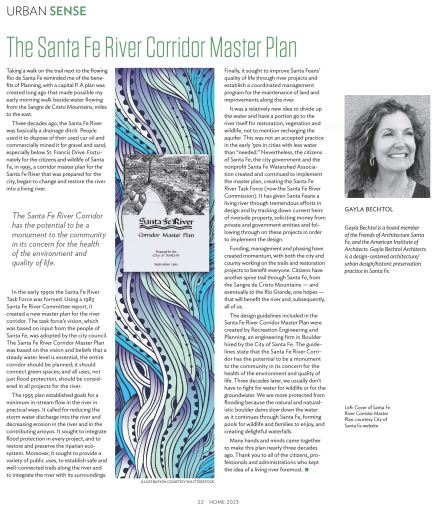In the August edition of The Santa Fe New Mexican’s Home Magazine, I discuss how the Santa Fe River Corridor Master Plan transformed the once-neglected Santa Fe River into a thriving ecosystem and recreational space over three decades. Urban Sense.
Read the Article:
Taking a walk on the trail next to the flowing Rio de Santa Fe reminded me of the benefits of Planning, with a capital P. A plan was created long ago that made possible my early morning walk beside water flowing from the Sangre de Cristo Mountains, miles to the east.
Three decades ago, the Santa Fe River was basically a drainage ditch. People used it to dispose of their used car oil and commercially mined it for gravel and sand, especially below St. Francis Drive. Fortunately for the citizens and wildlife of Santa Fe, in 1995, a corridor master plan for the Santa Fe River that was prepared for the city, began to change and restore the river into a living river.
In the early 1990s the Santa Fe River Task Force was formed. Using a 1983 Santa Fe River Committee report, it created a new master plan for the river corridor. The task force’s vision, which was based on input from the people of Santa Fe, was adopted by the city council. The Santa Fe River Corridor Master Plan was based on the vision and beliefs that a steady water level is essential; the entire corridor should be planned; it should connect green spaces; and all uses, not just flood protection, should be considered in all projects for the river.
The 1995 plan established goals for a minimum in-stream flow in the river in practical ways. It called for reducing the storm water discharge into the river and decreasing erosion in the river and in the contributing arroyos. It sought to integrate flood protection in every project, and to restore and preserve the riparian ecosystem. Moreover, it sought to provide a variety of public uses, to establish safe and well-connected trails along the river and to integrate the river with its surroundings. Finally, it sought to improve Santa Feans’ quality of life through river projects and establish a coordinated management program for the maintenance of land and improvements along the river.
It was a relatively new idea to divide up the water and have a portion go to the river itself for restoration, vegetation and wildlife, not to mention recharging the aquifer. This was not an accepted practice in the early ’90s in cities with less water than “needed.” Nevertheless, the citizens of Santa Fe, the city government and the nonprofit Santa Fe Watershed Association created and continued to implement the master plan, creating the Santa Fe River Task Force (now the Santa Fe River Commission). It has given Santa Feans a living river through tremendous efforts in design and by tracking down current heirs of riverside property, soliciting money from private and government entities and following through on these projects in order to implement the design.
Funding, management and phasing have created momentum, with both the city and county working on the trails and restoration projects to benefit everyone. Citizens have another spine trail through Santa Fe, from the Sangre de Cristo Mountains — and eventually to the Rio Grande, one hopes — that will benefit the river and, subsequently, all of us.
The design guidelines included in the Santa Fe River Corridor Master Plan were created by Recreation Engineering and Planning, an engineering firm in Boulder hired by the City of Santa Fe. The guidelines state that the Santa Fe River Corridor has the potential to be a monument to the community in its concern for the health of the environment and quality of life. Three decades later, we usually don’t have to fight for water for wildlife or for the groundwater. We are more protected from flooding because the natural and naturalistic boulder dams slow down the water as it continues through Santa Fe, forming pools for wildlife and families to enjoy, and creating delightful waterfalls.
Many hands and minds came together to make this plan nearly three decades ago. Thank you to all of the citizens, professionals and administrations who kept the idea of a living river foremost.


